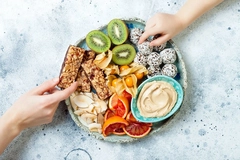Navigating flavor trends: Innova Market Insights flags how COVID-19 challenges behaviors, indulgence still key
21 May 2020 --- Innova Market Insights’ Flavor Trends for 2020 have been highly anticipated and the market researcher has surveyed consumers in 12 countries over the past several weeks, mapping changing consumer behaviors towards flavors amid the pandemic. Speaking yesterday during a webinar, Lu Ann Williams, Director of Innovation at Innova Market Insights, highlighted split responses as a result of COVID-19, with health and cost influencing purchasing patterns. Williams also flags how indulgence remains a key taste priority for many.
“We asked consumers if they were eating more as a result of the pandemic,” says Williams, noting there were different responses relating to indulgence. “In some of the countries that show a net decline in eating indulgent foods, there were significant differences among consumers. Some are actively looking to indulge less as they watch their health and expenditure on food, while others are indulging more for a variety of reasons,” she explains. 
Meanwhile, shared family mealtimes have become an integral part of the enjoyment during lockdown, Williams adds, referencing her own mealtimes at home. “We also see a lot of pockets of consumers who are looking to eat less indulgent foods with India as a standout, while China and Brazil are quite polarized,” she notes. “Health and cost are likely factors driving decreases. We have seen high levels of concern about the impact of COVID-19 on personal income and cost has become an important factor in purchasing food and beverages in many countries.”
This appears to be influencing the consumption of indulgent foods in some countries where the market researcher sees high percentages of low-income groups eating indulgent foods less, while higher income groups are indulging more. “Italian consumers show the highest net increase for eating indulgent foods more and India overall shows the second-largest net decrease,” comments Williams. According to Innova Market Insights, the sharpest decreases within lower incomes, single households (26 percent), single parents living with children (34 percent).
Meanwhile, there are still lots of opportunities for industry players looking to enhance their flavor capabilities, Williams flags. “We hear from customers and friends in the food industry who tell us that some things have been put on hold, with others saying they are taking advantage of doing things they haven’t had time to do.”
In the flavors arena, the pandemic will inevitably cause some minor and temporary blips. However, indulgent flavors are still paramount and many consumers are still very interested in new and exciting flavors, Williams affirms.
In relation to Innova Market insights’ Top Ten Trends for 2020, flavor “aligns very well with many of the themes, such as ‘Storytelling,’ plants, hybrids,” and Williams highlights how they impact the world of flavors.
“Trend number one, ‘Storytelling,’ portrays that consumers are increasingly captivated by the stories behind products,’ she comments. Many different aspects can captivate the story. Fifty-six percent of global consumers say that stories around a brand influence their purchase decision and 41 percent of global consumers want to know the story around a brand because they want to learn where the ingredients are from, explains Williams.
Storytelling also puts a spotlight on sustainably-sourced hero ingredients, she adds. “As an American, cranberries were something I grew up with. Today, they have gone mainstream; the story of how cranberries are grown and their nutritional qualities are part of their whole story,” says Williams.
Moreover, ingredient provenance and flavors created by small-batch craftsmanship also appeal to consumers looking for a story to a product. “Lots of flavors are being brought through in these stories, brands often use language that tells a nice story about these products,” she adds.
 Lu Ann Williams at Innova Market Insights, highlighted split responses as a result of COVID-19, with health and cost influencing purchasing patterns. She also flags how indulgence remains a key taste priority for many.The next flavor trend is “The Power of Plants.” “One question we have seen during the COVID-19 period is: is this trend going to remain?” muses Williams, highlighting a split between North America and Europe. “Plants are a huge topic that goes way beyond meat alternatives. We are seeing a pursuit of healthier lifestyles driving plant-based growth,” she notes.
Lu Ann Williams at Innova Market Insights, highlighted split responses as a result of COVID-19, with health and cost influencing purchasing patterns. She also flags how indulgence remains a key taste priority for many.The next flavor trend is “The Power of Plants.” “One question we have seen during the COVID-19 period is: is this trend going to remain?” muses Williams, highlighting a split between North America and Europe. “Plants are a huge topic that goes way beyond meat alternatives. We are seeing a pursuit of healthier lifestyles driving plant-based growth,” she notes.
According to a recent consumer survey conducted by Innova Market Insights, three in five consumers say they “increasingly incorporate plant-based ingredients into their diets.”
“Again, this crosses many categories, and it can be botanicals, coloring foods stuff and so on. It’s an extensive topic and these ingredients are soaring across many categories,” adds Williams.
For example, floral flavors are booming in F&B NPD. The fastest-growing floral flavors in global food and beverages are cherry blossom (29 percent), rose (26 percent) and lavender (25 percent).
Trend number three is “Wellness Flavors,” which target busy lifestyles and drive wellness innovation. “Busy lifestyles are impacting consumers across the globe,” states Williams. Thirty-nine percent of US consumers and 32 percent of UK consumers say they experience stress once a day or more.”
“Consumers are taking more holistic approaches to F&B and industry is responding significantly; we have seen a huge increase in new launches with botanical inclusions,” continues Williams, “And these bring functional and flavorful innovations to life. They also offer color and new taste experiences,” she says.
Innova’s number four trend, “Macronutrient Challenge,” highlights global influences but also local implications, according to Williams.
Sugar is at the top of the list for most countries as an ingredient that consumers are trying to avoid, she says. “The US still loves protein, and vitamins and minerals show good potential. This is one area where the pandemic is having a big impact, as consumers are concerned about their health and this could be a short term opportunity for many.”
Finally, “Tapping into Texture,” trend number five, flags the importance of indulgence and how flavors can create a richer texture experience.
“Seven in 10 consumers say that texture gives food and beverages a more interesting experience, while six in 10 consumers say texture claims in food and beverages influence their purchasing decisions,” Williams concludes.
By Elizabeth Green













